The bark beetle blues
As the infestation catches its breath, research picks up
Apr 15, 2013 - by Staff
Apr 15, 2013 - by Staff
Bob Henson • April 15, 2013 | Forests across western North America have been ravaged for more than a decade by mountain pine beetles and other bark beetles in the continent’s most extensive such attacks on record. Scientists at NCAR and their colleagues at universities and federal labs are now getting a better handle on what comes next for the forests and what it means for Earth’s carbon cycle. The answers aren't as straightforward as they expected.
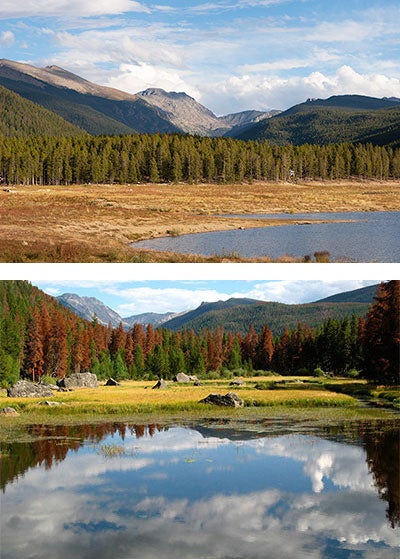
The saga of a mountain pine beetle attack, told in before-and-after scenes near Grand Lake, Colorado. The story starts with an intact lodgepole pine forest (top photo, taken in 2005). At some point, mountain pine beetles began encircling tree trunks, burrowing into the bark, and reproducing within it, feeding off the trees’ own flow of nutrients. In the summer following a beetle attack, the pine needles often turn a striking shade of red (bottom photo, taken in 2007). This can lead tourists to marvel at what they interpret as scenic fall color rather than the hallmark of dying trees. (© UCAR. Photos by Carlye Calvin.)
Aided by intense drought and warm winter temperatures, bark beetles have affected some 46 million acres of forest in the western United States, and millions more across Canada, over the last 13 years. Within those zones, beetle-killed trees have spanned as many as 10 million acres.
However, data from the U.S. Forest Service show that infestation rates for the mountain pine beetle have slowed over the last several years. The affected U.S. acreage dropped by more than 70% from 2009, the peak year, to 2012 (see PDF).
“I think the mountain pine beetles are running out of trees, for the most part,” says Jeffrey Hicke (University of Idaho).Hicke has recently led several comprehensive assessments of the beetle outbreaks and their impacts on wildfire (PDF), carbon (abstract), and tree mortality (abstract). Hicke notes that once an infestation rages through a suitable stand of trees, it may not be able to leap to the next vulnerable region, which could be hundreds of miles away.
While the mountain pine beetles now seem to be spreading at a less frantic pace, some areas are still vulnerable (see below), and other bark beetle species, including the spruce beetle, are on the move. Meanwhile, beetle-affected forests are going through a transformation whose impacts will continue to play out over centuries.
The drought of 2002 across much of the U.S. West killed many trees directly. It also laid the groundwork for many more to die from subsequent beetle attacks, since drought-stressed trees are less able to mount an effective biological defense. By the time more rain and snow returned to the region, beetles had become so numerous that many trees were already a lost cause.
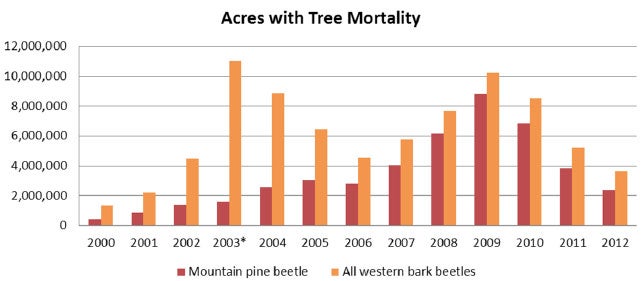
Mountain pine beetles (red) are just one of a number of bark beetle species chewing their way through western U.S. forests since 2000. This chart shows the number of acres with at least some loss of pine trees due to beetle attacks. The spike in 2003 (asterisk) is related to intensified surveying of piñon pine in New Mexico, which were heavily affected by the 2002 drought and related beetle damage. (Image from the report "Areas with Tree Mortality from Bark Beetles," March 15, 2013, courtesy U.S. Forest Service.)
“The beetle populations have been extremely high in recent years,” notes Hicke. “When there are a jillion beetles attacking a tree, they’re going to overwhelm the tree even if it’s healthy and well watered.”
Consistently mild weather is another key element at work. Temperatures of –40°F (–40°C) will reliably kill mountain pine beetles, and even readings of –4°F (–20°C) can cause some mortality if they occur when beetles are not fully acclimated. Beetles do generate their own cold-weather protection each year, a sort of internal antifreeze that’s most effective in midwinter. Although this past January was one of the coldest on record in the Great Basin, the frigid inversions were strongest at lower, less-forested elevations (see related post: When a good air mass goes bad).
Barbara Bentz (U.S. Forest Service, Rocky Mountain Research Station) is looking into how mountain pine beetles may have fared over the last few winters. This work is based a computer model (see PDF) driven by daily temperature data, with each year defined as extending from August 1 to July 31. Across Colorado, there is plenty of variation in temperature-driven impacts on beetles, a result of the state’s large range of topography and elevations. Overall, the toughest cold on mountain pine beetles across Colorado since the epidemic began was in 2010–11, says Bentz.
“Along the Front Range, the 2012–13 temperatures in fall and winter were not the best, but also not the worst for beetle survival,” she says. It will be at least this summer before aerial and ground surveys provide a more definitive answer on the past winter’s survival rates.
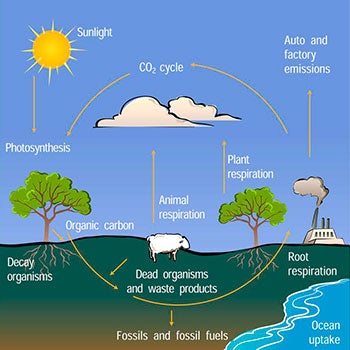
Carbon constantly moves through all living things, as well as through the oceans, atmosphere, and Earth's crust. (© UCAR. Illustration from UCAR Digital Image Library.)
Mountain pine beetles are a natural part of western ecosystems, one of many factors that keep forests moving through cycles of dying and regeneration. What’s different in recent decades is a gradually warming climate, which has helped turn what might have been a more typical outbreak into a continental-scale set of simultaneous epidemics.
Looking further ahead, the warmer winters consistently projected by climate models point to a continued risk of beetle population explosions. The particulars will vary from region to region and decade to decade, hinging not only on winter survival rates but also on how changing temperature regimes intersect with the timing of the beetles’ life cycles. (See our 2012 report on asynchrony between atmospheric and biological calendars.)
One might assume that the huge tracts of beetle-devastated forest now covering the West are wildfire disasters in the making. Wildland fires are, in fact, sometimes more intense in beetle-killed areas than elsewhere, though here again, the particulars make a difference.
Crown fires, the ones that leap from treetop to treetop, can be worsened during the first several years after a beetle attack. Once the trees are dead and needles have fallen, the threat of crowning typically drops, while surface-based fires can become more intense.
These effects don’t appear to be ever-present, though: Hicke says they may play a role only during certain weather or moisture conditions. The blog Wildfire Today weighed in on these complex results in a January post.
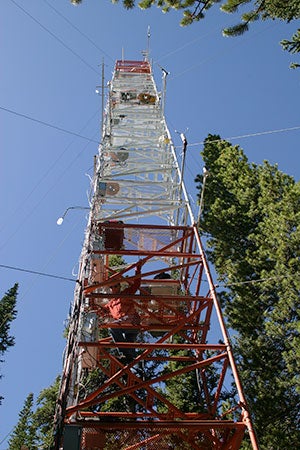
Instrumented towers help measure the flux of carbon dioxide into and out of mountain forests. Perched atop three steel towers provided by NCAR, each between 100 and 200 feet tall, carbon dioxide sensors and sonic anemometers measure changes in carbon levels and winds high above the treetops. This photo shows one of those towers on Niwot Ridge, west of Boulder. (© UCAR. Photo by Carlye Calvin.)
Forests play a huge role in Earth’s carbon budget. On average, about a quarter of all the carbon dioxide added to the atmosphere by human activity goes into forests and other vegetation “sinks,” while almost 30% goes into the oceans and the remaining 45% or so stays in the air.
But while ocean uptake changes slowly from year to year, the uptake on land can vary dramatically, which affects how much carbon ends up in the atmosphere. During a major El Niño, when drought and fire affect many lushly forested tropical regions, Earth’s vegetation can actually become a net carbon source rather than a sink, as was the case in 1997–98.
Many scientists once thought that large areas of beetle kill would have the same effect. “The general expectation we had was that when trees die on a large scale, it would lead to a big pulse of carbon into the atmosphere through microorganisms metabolizing all that dead wood,” says David Moore (University of Arizona). A 2008 study in Nature suggested that beetle-killed trees in Canada would serve as a net source of atmospheric carbon dioxide for a 20-year period.
New studies are revising that notion, including one led by Moore that appeared in Ecology Letters last month. This work is also nicely summarized in a University of Arizona news feature.
Moore and colleagues, including NCAR’s Britton Stephens, studied ten years in the lives of two closely monitored Colorado forests. One was about 70% infested by mountain pine beetles, and the other less than 6% affected.
“Surprisingly, we couldn’t find a big pulse of carbon dioxide,” says Moore.
Although trees pull large amounts of carbon dioxide from the air as they photosynthesize in daylight, the trees and the microbes in soil beneath them also respire, or “breathe out,” carbon dioxide. Just as when humans breathe, this adds carbon dioxide to the atmosphere.
The team found that while photosynthesis slowed by an average of 10–15% in the decade after a pine beetle attack, respiration also slowed by roughly the same amount, so there was little net effect on the carbon cycle.
“Rather than a large loss of carbon from trees and soil to the atmosphere, we found that both uptake and release slowed down,” Stephens says. As Moore puts it, “there seems to be a dampening of the carbon cycle.”
When a tree dies, microbes feasting on the wood pump additional carbon dioxide into the air. However, it can take decades for trees to fall down and decompose in high-altitude lodgepole forests, and over the first decade it appears that microbial activity decreases.
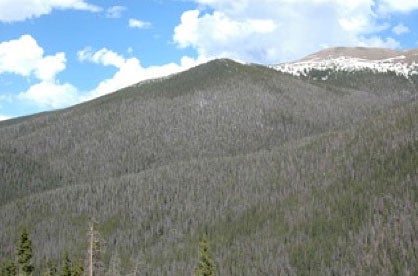
Pine trees devastated by beetles near Winter Park, Colorado. Within several years after a beetle attack, the reddened needles of a victimized pine tree fall to the ground, leaving behind the gray trunk and limbs. Dead trees may then topple for a decade or more afterward, a process called snagfall, while new growth sprouts up. (Photo by Jeff Hicke, University of Idaho.)
The upshot is that any infusions of carbon into the atmosphere from beetle-killed trees may happen more gradually than previously thought, which is good news in the effort to help minimize climate change from greenhouse gases in the near term.
While the new study may shift some widely held views about beetle kill and the carbon cycle, it is consistent with recent work carried out through the NCAR-based Community Land Model. Supported by NSF and the U.S. Department of Energy, the CLM simulates the ebb and flow of forests and the evolution of carbon and climate as part of the Community Earth System Model.
While visiting NCAR as a postdoctoral researcher, Steven Edburg (University of Idaho) used the CLM to simulate the effects of a beetle attack. He found that the carbon response varied hugely in the years following an outbreak, depending on the fraction of trees killed, the timing and pace of snagfall (dead trees toppling to the ground), and the rate at which dead trees were harvested, if at all. These factors “will have major impacts on post-outbreak carbon fluxes for several decades,” wrote Edburg and colleagues in a 2011 paper in the Journal of Geophysical Research.
When I asked Edburg about the new field results, he was intrigued but not overly surprised. “I think we’re in complete agreement,” he told me. For example, when the CLM simulated an outbreak with 75% tree mortality, it showed an overall drop in total respiration over the first decade. No field study until now had shown this model projection happening in the real world.
When the prescribed outbreak in the simulation is more fierce—95% mortality—it does serve as a net carbon source. However, when mortality is only 50%, the carbon flux into the atmosphere is much smaller, and interannual variability determines if the forest is a net source or sink of carbon from year to year. Moreover, these CLM simulations don’t include the growth of new plants, which would pull additional carbon from the air.
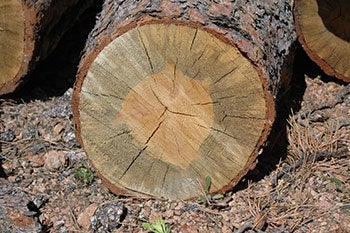
Mountain pine beetle attacks often leave wood with a distinctive blue-tinged stain. The blue color comes from two species of fungi brought into the tree by adult beetles. The fungi and beetles act symbiotically: beetles acquire vital nutrients by feeding on the fungi, and the fungi spread to other trees via the beetles. In some areas, this lumber is finding new life as a component of eco-chic furniture. (Photo by Jeff Hicke, University of Idaho.)
David Lawrence, a coauthor on the Edburg study, is part of the NCAR team that maintains and improves the CLM. “The beetle kill simulations that Steve worked on helped us learn several interesting things about possible responses of ecosystems to beetle kill, and we learned a lot about our model as well,” says Lawrence. “The new field results provide more information that could help further improve the model.”
NCAR’s Stephens has analyzed the carbon cycle from pole to pole through the multiyear HIPPO project. He notes the importance of nailing down carbon sources and sinks: “Huge sums of money could exchange hands based on where carbon appears to be going.”
As a Coloradan, Stephens is following the local epidemic with personal as well as professional interest. While the mountain pine beetle has tended to attack mainly lodgepole pine in Colorado, it’s been gravitating toward ponderosa pine in recent years. That’s one of the most commonly found trees along the foothills of Colorado’s populous Front Range.
“The jump to ponderosa pine seems to be happening in part of the Front Range and not in others,” says Jeff Hicke. “I don’t know exactly why it’s not happening more. There’s a lot of people waiting with bated breath to see what happens.”